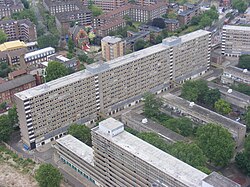Heygate Estate
| Heygate Estate | |
|---|---|

Aerial view of the Heygate Estate
|
|
| Location | Elephant and Castle, Walworth, Southwark, London, England |
| Coordinates | 51°29′35″N 0°05′46″W / 51.49306°N 0.09611°WCoordinates: 51°29′35″N 0°05′46″W / 51.49306°N 0.09611°W |
| Status | Demolished |
| Constructed | 1974 |
| Demolished | 2011–14 |
| Governing Body |
Southwark Council |
The Heygate Estate was a large housing estate in Walworth, Southwark, South London comprising 1214 homes. The estate was demolished between 2011 and 2014 as part of the urban regeneration of the Elephant and Castle area. Home to more than 3,000 people, it was situated adjacent to Walworth Road and New Kent Road, and immediately east of the Elephant and Castle road intersection. The estate was used extensively as a filming location, due in part to its brutalist architecture.
The Corbusian concept behind the construction of the estate was of a modern living environment. The neo-brutalist architectural aesthetic was one of tall, concrete blocks dwarfing smaller blocks, surrounding central communal gardens. The architect's concept was to link all areas of the estate via concrete bridges, so there was no need for residents to walk on pavements or along roads. In fact, it was even planned to build bridges to the neighbouring Aylesbury Estate, further south in Walworth.
Designed by Tim Tinker, the estate was completed in 1974.
The estate was once a popular place to live, the flats being thought light and spacious, but the estate later developed a reputation for crime, poverty and dilapidation. One resident complained about constant noise, crime and threats of violence as a result of the estate being used for temporary housing ahead of its redevelopment. He claimed that the sheer scale of many of the blocks also meant there was little sense of community. However, other residents disagreed that the estate should have been considered a slum and an eyesore, or that the buildings failed to foster a sense of community. Around 30 separate testimonies from former residents have been collated by a local microblogging site. Architect Tim Tinker described the estate's 'notorious' reputation as a "farrago of half-truths and lies put together by people who should have known better."
...
Wikipedia
